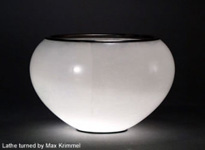So You Want to Turn Stone?
|
Alabaster is not difficult to turn and can be turned on most standard wood lathes or on metal lathes as well.
Bowls are a good shape to begin with as the open shape is easier to hollow than globes, vases or jars.
The most common way to attach the stone to the lathe is to first grind a flat spot on the base side of a piece with a belt sander or disk sander.
Next, glue on a scrap block of wood that can be screwed to the face plate of the lathe.
|

|
You should remove large corners or protrusions by sawing or grinding before using your lathe tools.
You can use a band saw or reciprocating saw to cut alabaster.
Carbide blades work best in case you encounter any quartz crystals.
Useful hand tools might also include an old hand saw or one with replaceable blades such as a coarse tooth hacksaw for small cuts or bow saw for larger cuts.
Alabaster is heavy and the stone should be fairly well balanced before turning on the power.
Standard steel scrapers rather than gouges work best on alabaster but carbide tipped tools stay sharp longer.
When we were kids, most of the tools we used were made from old machinist files ground to fit the job.
Here are just a couple of pointers. Try not to get too wide a cutting edge against the stone.
This helps prevent tool chattering.
The stone has no flexibility, so if you go thin, be very smooth and steady when using the tools.
See also Max Krimmel's Fine Woodworking article on the subject.
here
Stone is available from several sources. See Gordon Peterson's list
here.
|
|